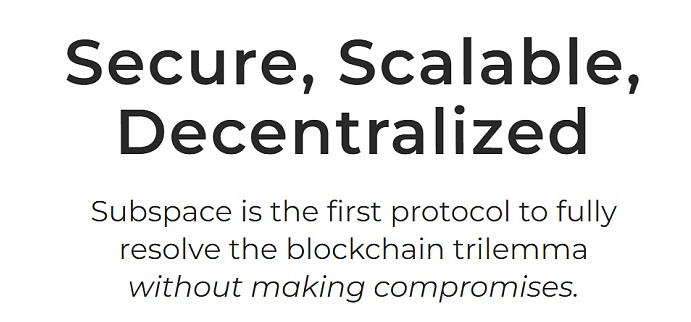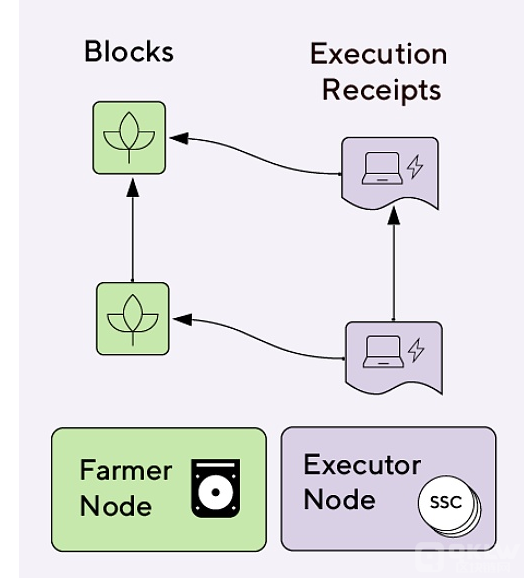Subspace Network 是Web3上支持大规模可扩展,同时提供存算一体化底层基础设施服务的模块化Layer-1,在此基础上,Subspace Network将致力于增强和连接其他区块链生态系统。
Roadmap:
2018年-2019年:获美国国家科学基金会 Grant 资助以及 Candaq Fintech Group, OneBoat Capital 等的早期支持
2021年:发布 Whitepaper,获得 Web3 基金会 Grant,$4.5 million fund raising led by Hypersphere and Stratos Technologies(Seed Round)
2022年:$33 million fund raising led by Pantera Capital & CoinBase(Strategic Round)
以下为Subspace Network中英文对照版白皮书 (Ⅰ) 。
Subspace: A Solution to the Farmer’s Dilemma
Subspace:解放被困的硬盘农民
第一章 背景
Nakamoto-style blockchains, such as Bitcoin [1] and Ethereum [2], [3], combine the longest-chain fork-choice rule with a proof-of-work (PoW) mining puzzle. These systems are provably secure, with respect to safety and liveness, given an honest majority of miners.
在目前的区块链世界中经典的中本聪式的区块链,如比特币和以太坊,他们无不是结合了最长链主链分叉决定原则和工作量证明(PoW)的算力博弈。这些系统也被证明是安全且可靠的,同时保持着相当程度的活跃,当然这很大程度上归功于大部分的工人都是诚实的。
Unlike legacy Byzantine Fault Tolerant (BFT) consensus algorithms, participation is both permissionless and scalable. These properties are the standard against which all new blockchain consensus protocols are measured.
与传统的拜占庭容错(BFT)共识算法不同,网络的参与双方是无需许可和可扩展的。这些属性是衡量所有新的区块链共识协议的标准。
Unfortunately, the security afforded by PoW comes at a massive cost in electricity. Collectively, miners on Bitcoin and Ethereum consume the energy budget of a medium-sized country, with these numbers steadily increasing as more capital flows into the system.
令人惋惜的是,目前PoW提供的高安全性是以巨大的电力成本为代价的。总的来说,比特币和以太坊上的矿工消耗了一个中等国家的能源预算,同时随着更多的资本流入该系统,这些电力以及各种综合成本会逐步增加。
This raises the critical question of whether cryptocurrencies can reach wide scale adoption without adding more fuel to the fire of global warming. Moreover, while mining was originally envisioned as a democratic and egalitarian process, as expressed by one-CPU-one-vote, it quickly became a highly commoditized and centralized enterprise.
这就提出了一个关键问题,即加密货币能否在低功耗,环境友好,不加剧全球变暖的情况下被广泛认可且采用。此外,虽然采矿最初被设想为一个民主且平等的过程,例如“每cpu一票”这样的设计,但好景不长,它很快就变成了高度商品化和集中化的产业。
Today participation in Bitcoin mining instead follows one-ASIC-one-vote, assuming a miner also Research conducted with support from NSF-SBIR Grant 1844037 has access to low-cost electricity. Ethereum mining sought to circumvent this by adopting one-GPU-one-vote, but this too has proven susceptible to special purpose hardware and still has the tendency to concentrate in regions with low-cost electricity. This raises another key question of whether or not existing cryptocurrencies are actually decentralized, or if we have simply substituted one trusted third-party (financial institutions) for another (mining pools).
如今,比特币采矿的参与已经被“一ASIC(专用集成电路)一票”给取代,假设一个矿工也在NSF-SBIR Grant 1844037的支持下进行研究,可以获得低成本的电力。以太坊采矿试图通过采用“每GPU一票”来规避这一问题,但这也被证明容易受到特殊用途硬件的影响,并且产业仍然倾向于集中在电力成本较低的地区。这就提出了另一个关键问题,即现有的加密货币是否实际上是去中心化的,或者我们是否只是简单地将一个受信任的第三方(金融机构)替换为另一个(矿池)。
These challenges have served as a rallying cry for a di-verse group of hackers, researchers, and engineers who have sought to design a sustainable blockchain that holds true to Nakamoto’s vision for a more democratic and decentralized future. The most well-known solution to this problem is proof-of-stake (PoS), which employs a system of virtual mining based on one’s wealth, under the adage one-coin-one-vote. While PoS clearly solves the ustainability problem, it doesnot hold true to Nakamoto’s vision. It instead reflects a permissioned and plutocratic alternative, which also exhibits strong tendencies towards centralization.
上述这些挑战成为了一群不同的黑客、研究人员和工程师的战斗口号,他们试图设计一个可持续发展的区块链,以实现中本聪对更加民主和去中心化未来的愿景。这个问题最著名的解决方案是权益证明(PoS),它采用基于个人财富的虚拟采矿系统,俗称“一币一票”。虽然 PoS 清晰地解决了可持续性问题,但它并不符合中本聪最初的愿景。相反,它反映了一种获得许可的财阀式的替代方案,它也表现出强烈的集中化趋势。
In fact, PoS systems serve to magnify the existing wealth disparity in cryptocurrencies, which are already significantly larger than historically high disparities in global fiat wealth distribution, effectively serving to make the rich even richer. What is instead needed is a cryptographic proof system based on an underlying resource that is already massively distributed and which does not lend itself to special-purpose hardware.
事实上,PoS系统会进一步放大加密货币中现有的财富差距,这种差距已经远远大于全球法定财富分配的历史最高差距,这有效地使富人变得更加富有。相反,我们需要的是一种基于底层资源的加密证明系统,该底层资源需要已经被大规模分布,并且不适合专用集成硬件。
Enter proof-of-capacity (PoC), which replaces compute-intensive mining with storage-intensive farming, under the maxim one-disk-one-vote. Disk-based consensus seems like an obvious choice, as storage hardware has long been commoditized, consumes negligible electricity, and exists in abundance across end-user devices. As it turns out, implementing a PoC such that it does not devolve back into PoW, without resorting to a permissioned model, is highly non-trivial, as witnessed by the paucity of live chains to date. Moreover, all existing PoC blockchain designs fail to address a critical mechanism design challenge, to which we turn next.
在“一盘一票”的原则下,容量证明(PoC)用存储密集型农业取代了计算密集型的耕种。基于磁盘形成的共识似乎是一个显而易见的选择,因为存储硬件早已商品化,消耗的电力可以忽略不计,并且在终端用户设备中大量存在。事实证明,在不采用许可模型的情况下,实施PoC以使其不会退回到PoW是非常重要的,正如目前我们所知道的,这样的链非常稀少。此外,所有现有的PoC区块链设计都无法解决关键的机制设计挑战,我们接下来要征服这个挑战。

第二章 农民困境
Observe that in any PoC blockchain a farmer is, by defifinition, incentivized to allocate as much of its scarce storage resources as possible towards consensus. Contrast this with the desire for all full nodes to reserve storage for maintaining both the current state and history of the blockchain.
在任何PoC区块链中,根据定义,农民被激励尽可能多地将其稀缺的存储资源分配给共识。这与所有完整节点为维护区块链的当前状态和历史而保留存储的愿望形成了对比。
These competing requirements pose a challenge to farmers: do they adhere to the desired behavior, retaining the state and history, or do they seek to maximize their own rewards, instead dedicating all available space towards consensus? When faced with this farmer’s dilemma rational farmers will always choose the latter, effectively becoming light clients, while degrading both the security and decentralization of the network.
这些相互竞争的要求对农民带来了挑战:他们是坚持所期望的行为而保留状态和历史,还是寻求个人回报最大化,而将所有可用的空间用于达成共识?当面对这种农民困境时,理性的农民总是会选择后者,成为轻客户以提升个人效率,同时降低了网络的安全性和去中心化。
This implies that any PoC blockchain would eventually consolidate into a single large farming pool, with even greater speed than has been previously observed with PoW and PoS chains.
这意味着任何PoC区块链最终都会合并成一个大型“耕种池(Farming Pool)”,其速度甚至比之前用PoW和PoS链观察到的还要快。
Recall that in any Nakamoto-style blockchain, a new consensus node must synchronize the chain state from genesis, in order to be assured they are actually on the longest valid chain, which implies the availability of the chain history. If a large fraction of nodes stores the history, this data will be readily available, and the network may be considered decentralized.
回想下在任何中本聪式的区块链中,一个新的共识节点必须从创世开始同步链的状态,以确保他们在最长的有效链上,这意味着链上历史的可用性。如果有很大一部分节点储存了历史,这些数据将很容易获得,网络也实现了去中心化。
However, as time goes by and the history grows, the storage burden on all full nodes grows as well, and some nodes may choose to prune the history, instead only storing the current state of the chain. This trend was already clear in the Bitcoin network as early as 2014 [5]. If full nodes do not store the history, new nodes must instead rely on altruistic archival nodes or third-party data stores for initial synchronization, resulting in a more centralized network. In a PoC blockchain farmers have nothing to gain by storing the history, but clearly stand to lose out on block rewards, especially as the history grows, consuming a larger fraction of their available disk space.
然而,随着时间的推移和历史的增长,所有完整节点上的储存负担也会增加,一些节点可能会选择删除历史,仅保留链的当前状态。这种趋势早在2014年的比特币网络中就已经很明显了[5]。如果完整节点不储存历史记录,那么新节点必须依赖利他的存档节点或第三方数据存储进行初始同步,从而导致网络更中心化。在PoC区块链中,农民通过存储历史没有任何好处,反而会失去区块奖励,特别是随着历史记录的增加,可用磁盘空间的消耗也越来越大。
In order to extend the longest valid chain and collect fees for valid transactions, a farmer must maintain the memoized state of the chain. As the state is often too large to reside in memory, it too must compete with consensus for precious disk space. While perhaps negligible for low-throughput UTXO style chains, state storage is signifificant for any EVM style chain, or any chain which seeks base layer scalability. Furthermore, all farmers are also required to compute the state transition for each new block as part of the ongoing verifification process, imposing a non-negligible computational overhead, which conflflicts with the desire for farming to be a lightweight task. The farmer’s dilemma then serves to exacerbate the well known verififier’s dilemma, by further raising the opportunity cost of verifification [6].
为了延长最长的有效链并收取有效交易的费用,农民必须保持该链的记忆状态。由于状态通常太大,无法储存在内存中,它也必须与共识争夺宝贵的磁盘空间。虽然对于低通量的UTXO链来说可能可以忽略不计,但状态存储对于任何EVM链或任何寻求底层可扩展性的链都是非常重要的。此外,作为正在进行的验证过程的一部分,所有农民还需要计算每个新区块的状态转换,造成了不可忽视的计算开销,这与农民执行轻量级任务的愿望相冲突。农民困境进一步提高了验证的机会成本,从而加剧了众所周知的验证者困境[6]。
If a farmer is willing to adopt a weaker security model, they may instead join a trusted farming pool, whereby they delegate transaction verifification and block proposing functions to an operator, while the farmer focuses solely on evaluating the block challenge against their plots. This has the added benefifit of drastically reducing the computational overhead required to participate in consensus, which fifits with the ideal of many small farmers pledging unused disk space on their home computers. When a farmer fifinds a valid solution to the block challenge, they send it to the pool operator, who forges the new block in return for a portion of the block reward. As long as the fee is lower than the opportunity cost of local block production, a rational farmer would always choose to join a pool. In PoW blockchains this choice is largely dictated by a desire for a smoother reward function, since, unlike joining a farming pool, joining a mining pool does not increase one’s total rewards.
如果农民愿意采用较弱的安全模式,他们可以加入一个可信的耕种池,即他们将交易验证和区块提议功能委托给运营商,而农民只专注于评估针对其地块的区块挑战。这样做的额外好处是,大幅减少了参与共识所需的计算开销,满足了许多小农民在他们的家用电脑上利用未使用的磁盘空间的理想。当农民找到一个有效的区块挑战解决方案时,他们会将其发送给耕种池运营商,后者铸造新的区块以换取一部分区块奖励。只要费用低于本地区块生产的机会成本,理性的农民总是会选择加入池子。在PoW区块链中,这种选择很大程度上取决于对更平滑的奖励功能的渴望,因为与加入一个耕种池不同,加入一个矿池并不会增加一个人的总回报。
The chief problem with this model is that it is not decentralized. Although the actual consensus hardware is highly distributed, compared to existing PoW mining pools, the operators still present a point of centralization, more akin to validators in delegated or nominated PoS protocols. However, PoS systems at least provide strong penalties for misbehavior, which have worked in practice so far. As farmers in the pooled model are at best acting as light clients, the scope of action for malicious or colluding operators is much higher than in a typical blockchain. The honest majority farmer assumption becomes an honest majority operator assumption. If that assumption does not hold, farmers, and most users, will be unable to distinguish between valid and fraudulent transactions which appear in the longest chain, allowing operators to create coins out of thin air or spend farmer and user funds at will.
这个模型的主要问题是它不是去中心化的。尽管实际的共识硬件是高度分布的,但与现有的PoW矿池相比,运营商仍然是一个中心化的点,更类似于委托或提名的PoS协议中的验证者。然而,PoS系统至少为不当行为提供了强有力的惩罚,这在迄今为止的实践中已经奏效。由于池化模型中的农民充其量只能作为轻客户,因此运营商的恶意或串通行动范围会比典型的区块链要高得多。多数农民是诚实的假设变成了多数运营商是诚实的假设。如果这种假设不成立,农民和大多数用户将无法区分在最长链中的有效交易和欺诈性交易,从而允许运营商凭空创建币或者随意花费农民和用户的资金。
PoC blockchain design appears to stuck on the horns of a dilemma. On the one hand, we may abandon the goal of having farmers retain the history, while doing everything possible to minimize the burden of maintaining the state such that that the opportunity costs of running a full node remain negligible, giving farmers little incentive to pool. This leads to a much more limited construction, ruling out stateful smart contracts and even modest base layer scalability. On the other hand, we can abandon Nakamoto’s vision and accept pooled consensus as a necessary evil, as has largely been done within the PoW and PoS communities, while at least rejoicing in the fact that participation is now fair and sustainable.
PoC区块链的设计似乎陷入了进退两难的境地。一方面,我们可以放弃让农民保留历史的目标,同时尽一切可能将维护状态的负担最小化,从而使运行一个完整节点的机会成本仍然可以忽略不计,让农民没有什么动力去汇集。这导致了一个更有限的结构,排除了有状态的智能合约和适度的基础层扩展性。另一方面,我们可以放弃中本聪的愿景,将池化共识接受为一种必要之恶,就像PoW和PoS社区所做的那样,同时为现在的参与是公平和可持续的而感到高兴。
In this work we present a third option, which circumvents the farmer’s dilemma without sacrifificing the security or decentralization of the network, organized as follows:
在这项工作中,我们提出了第三种选择,在不牺牲网络的安全性或去中心化的情况下,规避了农民困境。观点如下:
1) To prevent farmers from discarding the history, we construct a novel PoC consensus protocol based on proofs-of-storage of the history of the blockchain itself, in which each farmer stores as many provably-unique replicas of the chain history as their disk space allows.
1)为了防止农民丢弃历史,我们构建了一个基于区块链本身历史存储证明的新型PoC共识协议,每个农民在其磁盘空间允许的情况下存储尽可能多的,可证明是唯一的链上历史副本。
2) To ensure the history remains available, farmers form a decentralized storage network, which allows the history to remain fully-recoverable, load-balanced, and effificiently-retrievable.
2)为了确保历史的可用性,农民形成了一个分散的存储网络,使历史保持完全可恢复、负载平衡和有效检索。
3) To relieve farmers of the burden of maintaining the state and preforming redundant computation, we apply the classic technique in distributed systems of decoupling consensus and computation. Farmers are then solely responsible for the ordering of transactions, while a separate class of executor nodes maintain the state and compute the transitions for each new block.
3)为了减轻农民维护状态和进行冗余计算的负担,我们采用了分布式系统中的经典技术,将共识和计算解耦。此后,农民只负责交易的排序,而另一类执行者节点则维护状态并计算每个新区块的转换。

4) To ensure executors remain accountable for their actions, we employ a system of staked deposits, verififiable computation, and non-interactive fraud proofs.
4)为了确保执行者对其行为负责,我们采用了一个由押金、可验证的计算和非交互式欺诈证明组成的系统。
For concreteness, we present this approach within the Ethereum model of a fully-programmable, account-based blockchain, which periodically commits to the state of all accounts within the block header, though we believe many of the proposed techniques could be applied more generally for any Nakamoto-style blockchain.
具体而言,我们在以太坊模型中提出这种方法,即完全可编程的、基于账户的区块链,它将定期提交区块头内所有账户的状态。我们相信,此中的许多技术也可以更广泛地应用于任何中本聪风格的区块链。